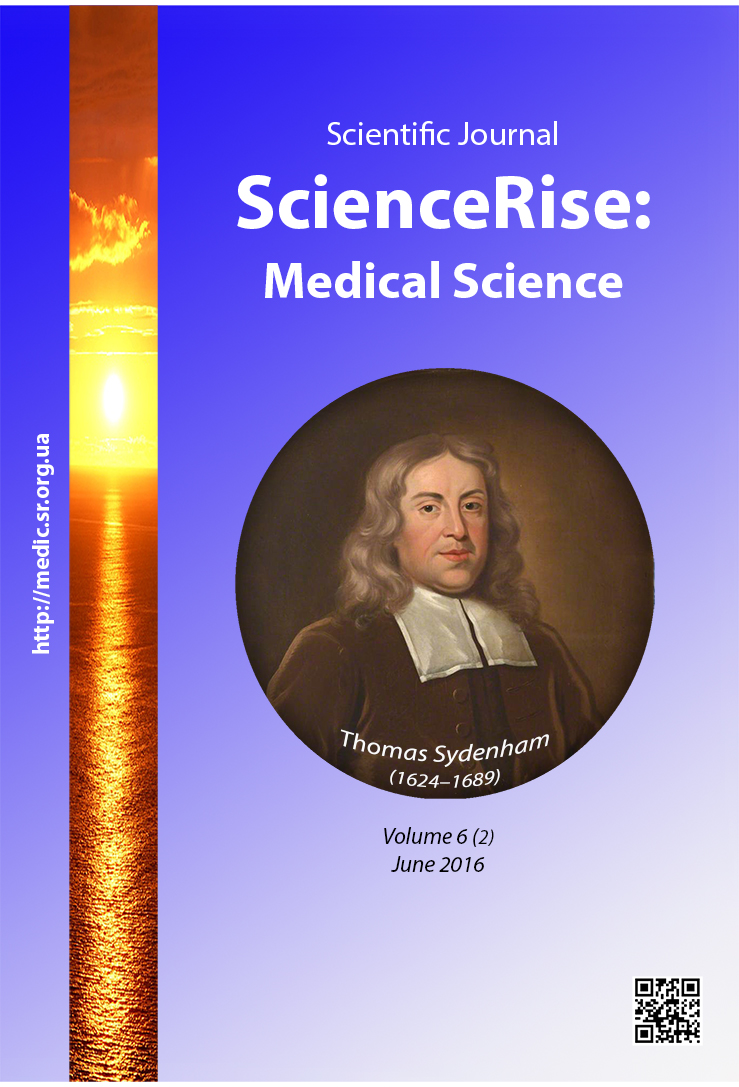Вміст есенціальних мікроелементів в організмі дітей з відставанням у зрості в залежності від ступеня низькорослості
DOI:
https://doi.org/10.15587/2519-4798.2016.72754Ключові слова:
есенціальні мікроелементи, волосся, плазма крові, діти та підлітки, низькорослістьАнотація
Вивчали вміст есенціальних мікроелементів (цинк, селен, марганець, хром, мідь) в організмі дітей з відставанням у зрості в залежності від ступеня низькорослості. Виявлено чіткий взаємозв’язок між ступенем відставання в зрості та вмістом цинку в волоссі дітей з низькорослістю
Посилання
- Ibragimov, M. Ya., Sabirova, L. Ya., Berezkina, Ye. S. et. al. (2011). Relationship of macro- and micronutrients imbalance and population health (review). Kazan. Med. Zhurnal, 92 (4), 606–609.
- Pogorelov, N. V., Bumeyster, V. I., Tkach, H. F. et. al. (2010). Macro- and microelements (metabolism, pathology and determination methods). Sumy, 147.
- Tretiak, L. N., Skalny, A. V., Bogatova, O. V. (2011). Minerals, micronutrients and child health. Microelementy v meditsine, 12 (1-2), 1–6.
- Klatka, M., Błażewicz, A., Partyka, M., Kołłątaj, W., Zienkiewicz, E., Kocjan, R. (2015). Concentration of Selected Metals in Whole Blood, Plasma, and Urine in Short Stature and Healthy Children. Biological Trace Element Research, 166 (2), 142–148. doi: 10.1007/s12011-015-0262-2
- Kazi, T. G., Afridi, H. I., Kazi, N., Jamali, M. K., Arain, M. B., Jalbani, N., Kandhro, G. A. (2008). Copper, Chromium, Manganese, Iron, Nickel, and Zinc Levels in Biological Samples of Diabetes Mellitus Patients. Biological Trace Element Research, 122 (1), 1–18. doi: 10.1007/s12011-007-8062-y
- Lin, C.-C., Tsweng, G.-J., Lee, C.-F., Chen, B.-H., Huang, Y.-L. (2016). Magnesium, zinc, and chromium levels in children, adolescents, and young adults with type 1 diabetes. Clinical Nutrition, 35 (4), 880–884. doi: 10.1016/j.clnu.2015.05.022
- Mwiti Kibiti, C., Jide Afolayan, A. (2015). The Biochemical Role of Macro and Micro-Minerals in the Management of Diabetes Mellitus and its Associated Complications: A Review. International Journal for Vitamin and Nutrition Research, 85 (1-2), 88–103. doi: 10.1024/0300-9831/a000226
- Sujatha, P. (2013). Trace Elements in Diabetes Mellitus. Journal of clinical and diagnostic research. doi: 10.7860/jcdr/2013/5464.3335
- Salgueiro, M. J., Zubillaga, M. B., Lysionek, A. E., Caro, R. A., Weill, R., Boccio, J. R. (2002). The role of zinc in the growth and development of children. Nutrition, 18 (6), 510–519. doi: 10.1016/s0899-9007(01)00812-7
- Grabeklis, A. R., Lakarova, E. V., Eisazadeh, S., Skalny, A. V. (2011). Sex dependent peculiarities of some important chemical element ratios in hair of schoolchildren. Trace Elements and Electrolytes, 28 (04), 88–90. doi: 10.5414/tep28088
- Mayo-Wilson, E., Junior, J. A., Imdad, A., Dean, S., Chan, X. H. S., Chan, E. S. et. al. (2014). Zinc supplementation for preventing mortality, morbidity, and growth failure in children aged 6 months to 12 years of age. Cochrane Database Syst. Rev. doi: 10.1002/14651858.cd009384.pub2
- Binitha, M., Sarita, S., Betsy, A. (2013). Zinc deficiency associated with hypothyroidism: An overlooked cause of severe alopecia. International Journal of Trichology, 5 (1), 40. doi: 10.4103/0974-7753.114714
- Ahsan, U., Kamran, Z., Raza, I., Ahmad, S., Babar, W., Riaz, M. H., Iqbal, Z. (2014). Role of selenium in male reproduction – A review. Animal Reproduction Science, 146 (1-2), 55–62. doi: 10.1016/j.anireprosci.2014.01.009
- Bains, K., Kaur, H., Bajwa, N., Kaur, G., Kapoor, S., Singh, A. (2015). Iron and Zinc Status of 6-Month to 5-Year-Old Children From Low-Income Rural Families of Punjab, India. Food and Nutrition Bulletin, 36 (3), 254–263. doi: 10.1177/0379572115597396
- Forte, G., Bocca, B., Peruzzu, A., Tolu, F., Asara, Y., Farace, C. et. al. (2013). Blood Metals Concentration in Type 1 and Type 2 Diabetics. Biological Trace Element Research, 156 (1-3), 79–90. doi: 10.1007/s12011-013-9858-6
- Azab, S. F., Saleh, S. H., Elsaeed, W. F., Elshafie, M. A., Sherief, L. M., Esh, A. M. (2014). Serum trace elements in obese Egyptian children: a case–control study. Italian Journal of Pediatrics, 40 (1), 20. doi: 10.1186/1824-7288-40-20
- Błażewicz, A., Klatka, M., Astel, A., Korona-Glowniak, I., Dolliver, W., Szwerc, W., Kocjan, R. (2015). Serum and urinary selenium levels in obese children: A cross-sectional study. Journal of Trace Elements in Medicine and Biology, 29, 116–122. doi: 10.1016/j.jtemb.2014.07.016
- López-Bellido Garrido, F. J., López Bellido, L. (2013). Selenium and health; reference values and current status of Spanish population. Nutr. Hosp, 28 (5), 1396–1406. doi: 10.3305/nh.2013.28.5.6634
- Wood, R. J. (2009). Manganese and birth outcome. Nutrition Reviews, 67 (7), 416–420. doi: 10.1111/j.1753-4887.2009.00214.x
- Anderson, R. A. (1998). Chromium, Glucose Intolerance and Diabetes. Journal of the American College of Nutrition, 17 (6), 548–555. doi: 10.1080/07315724.1998.10718802
- Neve, J. (1992). Clinical implications of trace elements in endocrinology. Biological Trace Element Research, 32 (1-3), 173–185. doi: 10.1007/bf02784602
- Bumoko, G. M.-M., Sadiki, N. H., Rwatambuga, A., Kayembe, K. P., Okitundu, D. L., Mumba Ngoyi, D. et. al. (2015). Lower serum levels of selenium, copper, and zinc are related to neuromotor impairments in children with konzo. Journal of the Neurological Sciences, 349 (1-2), 149–153. doi: 10.1016/j.jns.2015.01.007
- Locks, L. M., Manji, K. P., McDonald, C. M., Kupka, R., Kisenge, R., Aboud, S. et. al. (2016). Effect of zinc and multivitamin supplementation on the growth of Tanzanian children aged 6-84 wk: a randomized, placebo-controlled, double-blind trial. American Journal of Clinical Nutrition, 103 (3), 910–918. doi: 10.3945/ajcn.115.120055
- Tabatadze, T., Zhorzholiani, L., Kherkheulidze, M. et. al. (2015). Association between short stature and hair elements. Georgian Med. News, 247, 25–30.
##submission.downloads##
Опубліковано
Як цитувати
Номер
Розділ
Ліцензія
Авторське право (c) 2016 Вікторія Геннадіївна Пахомова, Олена Василівна Большова

Ця робота ліцензується відповідно до Creative Commons Attribution 4.0 International License.
Наше видання використовує положення про авторські права Creative Commons CC BY для журналів відкритого доступу.
Автори, які публікуються у цьому журналі, погоджуються з наступними умовами:
1. Автори залишають за собою право на авторство своєї роботи та передають журналу право першої публікації цієї роботи на умовах ліцензії Creative Commons CC BY, котра дозволяє іншим особам вільно розповсюджувати опубліковану роботу з обов'язковим посиланням на авторів оригінальної роботи та першу публікацію роботи у цьому журналі.
2. Автори мають право укладати самостійні додаткові угоди щодо неексклюзивного розповсюдження роботи у тому вигляді, в якому вона була опублікована цим журналом (наприклад, розміщувати роботу в електронному сховищі установи або публікувати у складі монографії), за умови збереження посилання на першу публікацію роботи у цьому журналі.










